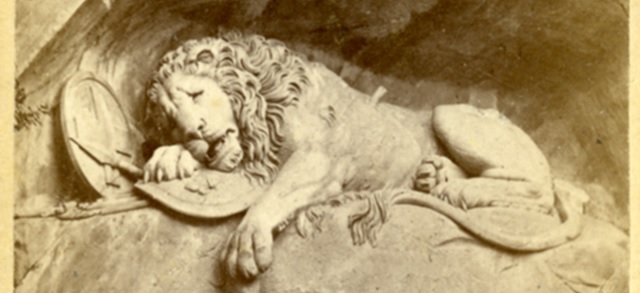
Monuments Class Projects
Architect/Sculptor of Monument
Hans Konrad Siegfried (Architect) Georg Ludwig Vogel (Inspired by)
Preview

Identifier
04a
Medium
photograph, carte-de-viste
Keywords
William Tell, Wilhelm Tell, Statue of William Tell, Statue of Wilhelm Tell. Statues in Switzerland
Physical Dimensions
99mm x 62mm
Name of Monument
Wilhelm Tell
Date of Completion or Dedication of Monument
Spring 1860
City of Monument
Altdorf
Location within City
Tellgasse
State/Province of Monument
Canton of Uri
Country of Monument
Switzerland
Description
In Altdorf, Switzerland, this monument depicts Swiss folk hero William Tell with an arm resting on his crossbow and the other outstretched holding the arrow that famously shot the apple off his son’s head. The location of the statue is supposedly where William Tell shot the apple for his freedom. It was designed and sculpted by Hans Konrad Siegfried and was inspired by the Tell Statue on top of the Eidgenössisches Freischiessen Triumphal Arch in Zürich (pictured to the right), home to the first and largest shooting festival.
School of Art/Architecture
Neoclassical Sculpture
Digital Date
1-19-2022
Copyright
Original physical carte-de-visite is in the public domain. Digital copy scanned by Rod Library, ©2022 Rod Library, University of Northern Iowa.
Rights Advisory
Original print carte-de-visite card is in the public domain; U.S. and International copyright laws protect this digital object. Commercial use of this digital object is not permitted without prior permission of the copyright holder.
Creative Commons License

This work is licensed under a Creative Commons Attribution-NonCommercial 4.0 International License
File Format
image/jpeg



Comments
Background
Depicted in this CDV is a statue of the Swiss folk hero, William Tell, a man mired in myth and legend. My research into this statue began with the man himself and the stories surrounding him to look at why he had a statue of him. To get a better insight into this, I believe there is no better place to look than the theatrical production about Tell written by Friedrich Schiller.
The German playwright debuted his namesake play about Tell on March 17, 1804. According to translator Gilbert Jordan, there is no evidence that William Tell had ever existed and instead he was a symbol or rallying cry for Swiss pride and liberation from the Austrian Hapsburgs who would go on to be the main antagonists of the play1. In addition to the artistic liberties so too are the other characters in the story. Jordan later goes on to mention that many of the villains in the book either did not exist or were not as horrible as Schiller made them out to be. With the factual disclaimer out of the way, I figure I should talk about what actually happens in the story of William Tell by examining three scenes that describe precisely who and what William Tell is all about.
The play begins with a conversation between a fisherman and some farmers talking about their animals and the impending storm on the horizon. Their pleasantries are interrupted by a man named Baumgarten rushes and begs for their aid across the lake. This man is being hunted by the emperor for he had killed his bailiff moments ago because he was trying to seduce his wife. The farmers plead with the fisherman to take him across the lake, but the man laments and tells Baumgarten that the storm is rolling in and he will not risk his life. When all hope seems lost for the convict, William Tell gallantly swoops in and tells the fisherman that he will sail the man across the lake. The two set off leaving the fisherman and farmers to stare at Tell in disbelief at his perseverance and willingness to risk his own life for his fellow man. This first scene paints Tell as the stereotypical knight in shining armor who will appear out of nowhere to save the day with complete disregard for his life.
The next scene I’d like to talk about actually explores Tell’s willingness to commit to the liberation of Switzerland from the tyrannical Hapsburgs. After a lot of scenes depicting the other characters and the savagery of the viceroy Hermann Gessler, the story cuts to William Tell returning to his family at the beginning of act three. During this scene Tell’s children, Wilhelm and Walter, both approach their father as he returns and want to show off that their training has gotten better since he was last home. This display of archery spurs a heated conversation between Tell and his wife Hedwig. The two argue over Tell’s recklessness because he is always risking his life to save others that a day will come when no one will be able to rescue him. Tell sees this as him being committed whereas his wife believes he is tempting God. I really enjoyed this scene because it really personalizes Tell and his wife and felt like an honest conversation a couple would have in this situation.
The final scene I wanted to talk about is the portion of William Tell’s story that is the most widely known part about him, the infamous shooting the apple off the head. It all begins during act three, scene three when Tell and his son Walter are heading to Altdorf to meet with Hedwig’s father. The two travel until they are halted by two soldiers, Friesshard and Leuthold. These two keep their spears pointed at Tell and tell him that he is to be arrested for being a traitor because he did not pay his tax to the viceroy. Although Tell and the surrounding people lie to try and convince them otherwise, the viceroy shows up to solve the matter. Viceroy Gessler has heard tales of Tell’s marksmanship and in a desire to put him to the test, he gives Tell a wager for his freedom. Gessler says “Look, Tell, because they say you shot an apple down from the tree a hundred paces off, you’ll have to prove your skill”2. What then happens is by far what surprised me the most about this scene. Tell agrees and the crowd present believes him mad and tries talking him down from the idea, but both Tell and Gessler are not backing down. His son Walter is tied to the tree and as he takes aim in the background, the crowd pleads with Gessler to stop this madness. Whilst they are talking with the viceroy a woman interrupts them to point out that Tell had landed the arrow and the people rejoice.
At first I thought this was a rather weird way to depict the scene we all know him for, but the more I thought about it the more it made sense. This feat was something nerve racking that would cause anyone to buckle under the stress of it and the fact that he pulls it off so nonchalantly only builds on the mythological features of William Tell. This play perfectly encapsulated exactly why the city of Altdorf reveres the man so much. The famous scene supposedly takes place in the city which coincidentally is also the supposed location of the statue depicted in the CDV.
Before I talk about the statue in the CDV I would like to first thank Dr. Thomas Brunner from the Department of Justice of the Canton of Uri and my good friend Karl Wiessman. Dr. Brunner was kind enough to not only send over a scan of the source of information about the statue but also shed some light on it as well that was not covered in the book. My friend Karl Wiessman is a German native and has been acting as my German translator as well as a research aid during the hunt for any concrete information on this statue. Without their help, this project would not have been possible.
The statue seen in the CDV was built by Hans Konrad Siegfried and was erected in 1860 on Tellgasse, where the apple shot possibly happened. The design of the statue was based on the Tell Statue on top of the Eidgenössisches Freischiessen Triumphal Arch in Zürich by Georg Ludwig Vogel3. The statue depicts William Tell with one hand resting on his crossbow and his other outstretched with the arrow that shot the apple. Because it was made from plaster, it was not built to last for terribly long in the climate of Altdorf and was eventually taken down in 1891 when the current Tell monument was erected. The main artistic difference between the two is the current one also includes his son Walter next to him whereas Siegfried’s does not.
Bibliography
Rebsamen, Hanspeter, et al. The Inventory of Swiss Architecture 1850-1920. Vol. 1, ETH Library, 1984. https://www.e-periodica.ch/digbib/view?pid=ins-001%3A1984%3A1#195 Friedrich Von Schiller.
Johann. Wilhelm Tell. Translated by Gilbert J. Jordan, The Bobbs-Merrill Company, 1964.
[1] Friedrich Von Schiller, Johann. Wilhelm Tell page xxxi.
[2] Friedrich Von Schiller, Johann. Wilhelm Tell page 117 line 1885.
[3] Rebsamen, Hanspeter, et al. The Inventory of Swiss Architecture 1850-1920 page 195.